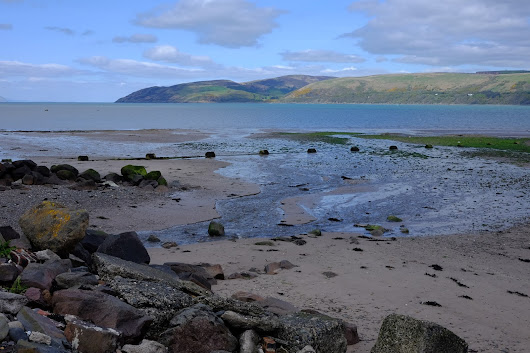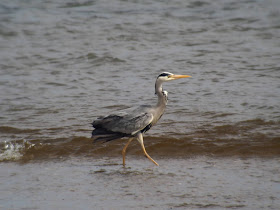For once I'm going to start this week's post off chronologically, for on Monday we saw a nuthatch. These little birds are regular in the area but still manage to hide away in the treetops - despite all the noise that they are all-too-often making. Other small passerines (perching birds) that we have seen this week include a grey wagtail, 2 siskins, 3 greenfinches, a total of 3 redwings and approximately 1000 starlings (our highest flock so far this winter). We have had highest day-counts of 20 goldfinches, 3 rock pipits and roughly 60 twite. The latter species had better be on guard - for a male merlin was seen hunting last week.
 |
| A flock of twite |
Moving onto our waterfowl and waders, the number of teal at Loch Connell increased to 274 while the pale-bellied brent goose flock at the Wig saw a highest count of 288. Our regular 3 bar-tailed godwits remained, whilst curlews saw a highest day-count of 79 and a flock over 120 pink-footed geese flew overhead. A ringed plover flock of roughly 50 blended in with the pebbles, 9 snipe made an appearance one day and later in the week we saw 5 purple sandpipers on the scar. These were certainly a nice surprise - we hadn't expected to see any more purple sandpipers after our previous bird disappeared.
This week we went out to Piltanton Burn to do our monthly WeBS (Wetland Bird Survey) count, so we have even more waterfowl and waders than usual. 174 dunlins were scattered along the shoreline, along with 58 redshanks and 4 little egrets. A flock of circa 200 golden plovers wheeled overhead before disappearing into the distance - perhaps they had been put up by the kestrel that had flown by earlier. Paddling about were 6 greenshanks, 34 knots, 5 lapwings, 84 teal and over 168 wigeon. 88 shelduck were on the mudflats while in the river itself were 3 cormorants, 16 red-breasted mergansers and a shag (unusual to see swimming up the river, normally they stay out on Luce Bay). Finally, just as we were packing up to leave, 2 little grebes appeared - not a species we see there very often.
Continuing on from Piltanton, we decide to do a loop around West Freugh before heading towards Soulseat Loch. On the prowl for geese, we stopped to scan a flock of greylags and found behind them a flock of Greenland white-fronted geese. These lovely geese are always a delight to see - they rarely make their way to the Wig or Loch Connell. Given that they were half hidden behind a hedge, we moved on and round the corner we were able to get better views. As a bonus - just a few fields over was another flock of Greenland white-fronts! This was obviously the spot to be at that day, for along with the two flocks of white-fronts (42 and 46 birds) a ringtail hen harrier was hunting above the fields - and it proceeded to put up a merlin who had also been trying to hunt in the same area. Yellowhammers flew up and down the hedges and further up a bullfinch and a magpie were perched in a tree.
 |
| Distant flock of Greenland white-fronted geese |
After all that excitement, the light was beginning to fade when we got to Soulseat. Despite this, we were still able to count 3 cormorants, a coot, 17 goldeneyes (more than our highest day-count on Loch Ryan this week), 1 little grebe, 7 tufted ducks and 121 teals. There were also approximately 20 mallards, over 300 wigeon and a flock of greylag geese - unfortunately more accurate counts were interrupted by a low-flying aeroplane. Whilst not a bird, it was nonetheless very nice to see an otter sploshing about on the far side of Soulseat Loch.
It was a very exciting day out and appears to have stolen most of the show for this blog post! Fret not, all of our regular species are still present at the Wig and (the benefit of writing these posts a week late) I can assure you that there are some brilliant surprises to come next week...
[All photographs are taken by and belong to Stephen Grover, please ask for permission if you wish to use them.]




































